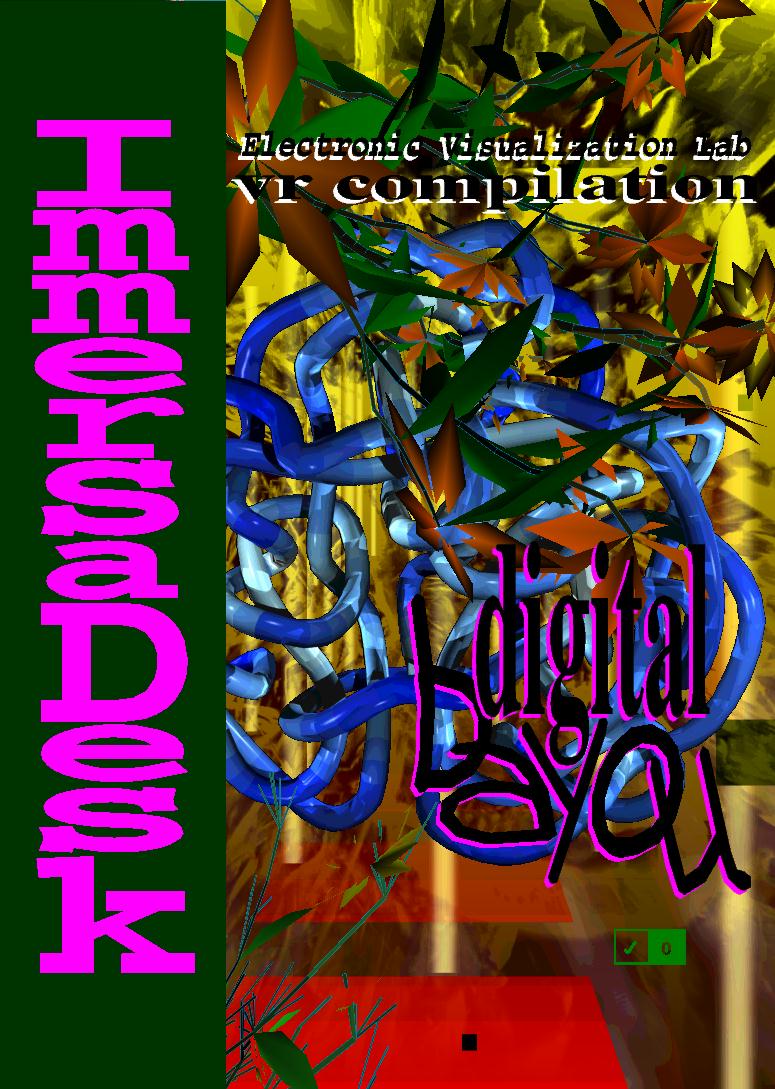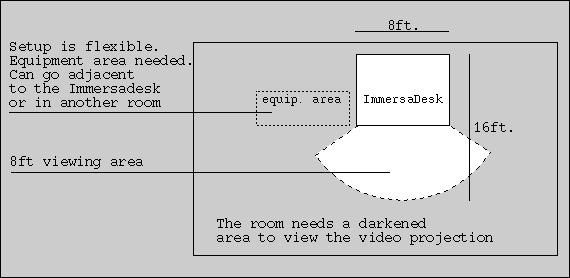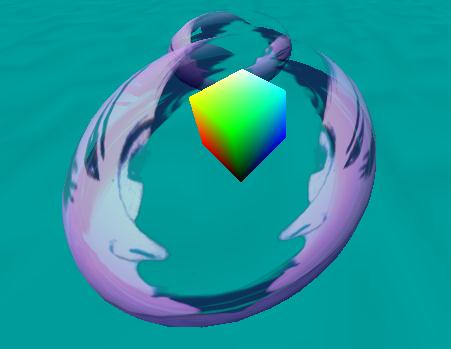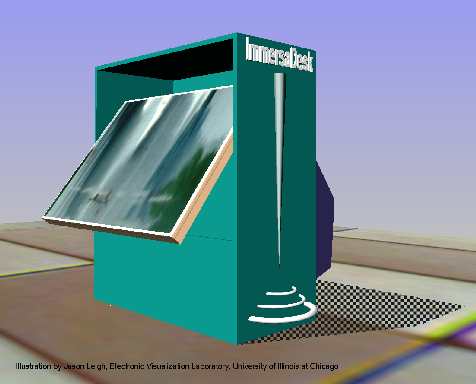

Project Title




This piece is a collaborative effort by the artists and scientists of the Electronic Visualization Lab (EVL) at the University of Illinois at Chicago. The applications presented represent the state-of-the-art in virtual reality using the ImmersaDesk, a projection-based, drafting-table-sized virtual reality system. These interactive works engage the viewers in experiences that break the traditional boundaries of art and science, by encouraging their active participation in the creative process of visually compelling environments.
This work is the continuation of a series of collaborative events organized by EVL, that involve integrating diverse interests to create an interactive and distributed participatory theater. The ImmersaDesk stages such "acts" as the Circus, a combination of live performance and vivid imagery of circus tents, in their unique virtual reality interpretation. Other ImmersaDesk applications simulate worlds where organic shapes can transform themselves into characters, where sculptural knots attempt to untangle, or where flocks of birds synchronize their movements in concert. The ImmersaDesk may be experienced as an installation that reflects the physical environment, or as an opportunity for young participants to interact directly with the virtual landscape and sculpt stories, in collaboration with other remote, human or artificial agents. The ImmersaDesk becomes a pinball machine, a mini-golf course, or a ski slope. It can take us on an interplanetary tour, or inside a seemingly realistic residence that hides passages to fictional worlds. It can let us play with the filament of a light bulb, or engage in a conversation with a ball of heads.
The fusion of disciplines is the basis for this unique collaborative effort. It suggests a model in which technology and art unite into creating highly interactive and immersive virtual environments where the artists become scientists and the scientists engage in artistic expression.

The physical installation of the ImmersaDesk creates an evocative setting for viewers to experience and participate in the worlds that unfold before them. The participants have the opportunity to view several different applications that represent the state-of-the-art in virtual reality development. Interaction depends on the application and can range from simple navigation and exploration of a space to active manipulation. This high resolution VR display system provides an excellent development platform for remote participants to collaborate in the construction of distributed virtual environments. During SIGGRAPH '96 plans are made for it to be connected to another ImmersaDesk or CAVE located at Ars Electronica in Austria and possibly other sites throughout the country. The viewers will have the opportunity to participate in these collaborations while experiencing an innovative interface to virtual reality technology, advanced visualization techniques, and high-end networking projects.

Interaction with the ImmersaDesk hardware is natural and unobtrusive. A total of five to six participants at a time wear light weight stereo glasses and stand in the area in front of the desk. The size and position of the screen give a sufficiently large wide angle view so the viewers feel fully immersed in the visual scene. Head tracking allows the participant to experience a first-person view as opposed to the third-person view that is experienced with other visual media. The participants do not only exist in but can also manipulate the virtual world in a variety of applications, with the use of a wand, which provides the main mechanism to track the user's hand position. Additionally, the area around the desk is surrounded by a directional sound system. Moreover, participants at remote sites have the opportunity to explore the same worlds and interact with each other just by connecting the ImmersaDesk with other ImmersaDesks or high performance computers around the world.


The ImmersaDesk is a projection-based, drafting-table-sized virtual reality system. The ideal location for the Immersadesk is a separate viewing room or a space accomodated by movable walls to create a partitioned area. The ImmersaDesk proper occupies an 8 x 8 foot square space. A 3' x 5' area adjacent to the Immersadesk is required to install and house the necessary computer hardware. An 8 foot space directly in front of the ImmersaDesk will accommodate ten viewers comfortably. A theater black environment provides ideal viewing of the applications which are enhanced with the sound and performance of technology and personnel. Due to the amount of equipment and supplies that will be combined with this exhibition, ample storage accomodations should be made available.


Margaret Dolinsky & Grit Sehmisch
To see other images click here.

Virtual reality is used to create environments where the meaning resides primarily in its immersive and interactive qualities. Both immersion and interactivity are extended with the use of the ImmersaDesk as an innovative interface to virtual reality. The size of the ImmersaDesk is compact yet sufficiently wide so the viewer feels fully immersed. Interaction is natural and unobtrusive, thus allowing access to non-expert users. Moreover, there are unlimited possibilities of, both remote and proximate, collaboration between users of the system. A big part of the current and future direction of the ImmersaDesk involves connecting remote sites to create distributed environments. Distributed virtual reality is thus more accessible, enabling truly international collaboration amongst scientists, artists, or collaborators representing other disciplines.

EVL advances research in computer graphics and interactive techniques through its unique interdisciplinary blend of engineering, science, and art; its students receive MS, PhD and MFA degrees through the UIC Electrical Engineering and Computer Science department and the UIC School of Art and Design. Most recently recognized for its work in virtual reality with the introduction of the CAVE(TM) virtual reality theater in 1992, EVL has a history of innovative contributions to the computer graphics field.
Last November, EVL organized and staged major events at ACM/IEEE Supercomputing '95. In 1994, the Lab organized the SIGGRAPH 94 VROOM event, a major virtual reality exhibition highlighting computational science and engineering applications. For SIGGRAPH 92, EVL organized Showcase, which featured 35 projects on workstations networked to onsite and remote supercomputers and illustrated interactive and collaborative visualization research; EVL's 1987 The Interactive Image, a multimedia exhibit that educated children and adults about computational science, is on permanent display at The Computer Museum in Boston and the St. Louis Science Center.
Additionally, EVL has been, and continues to be, a major influence on the advancement of electronic art and entertainment. EVL students, staff and faculty recently organized a very successful Electronic Visualization Event #4 in May 1995 that featured artistic virtual-reality demonstrations, video art, 2D and 3D computer-generated art, and installations.


Using LCD stereo glasses, head and hand tracking, the ImmersaDesk is a projection-based virtual reality system allowing relatively unencumbered group viewing of the virtual reality enviroment. The ImmersaDesk features a 4 x 5-foot rear-projected screen at a 45-degree angle. The size and position of the screen give an immersive wide angle view and the ability to look down as well as forward. The resolution is 1024 x 768 at 96Hz. The system also includes a directional sound system.
The Electronic Visualization Lab can provide:
SIGGRAPH96 is to provide (these items are open to negotiation):

Electrical requirements:
There are two possible electrical configurations.


Click here to see the completed application form
Electronic Visualization Laboratory
851 South Morgan Street
Room 1120
Chicago, IL 60607-7053
USA
+1.312.996.3002
+1.312.413.7585 fax